| |
|
St Peter,
Gorleston-on-Sea
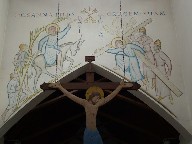 |
|
Gorleston
may seem an unlikely place to find one of the
great church architectural treasures of the
Twentieth Century. But here, just up the High
Street from the shops and set slightly back from
the road, is the only church designed by Eric
Gill. Twentieth Century English art seems to have
had more than its fair share of eccentrics, but
can any of its artists have been more eccentric,
and even controversial, than Eric Gill? Gill was
born in Brighton in 1882, and quickly established
himself as a genius of sorts. He was heavily
influenced by the English Arts and Crafts
movement, and trained as an architect with that
major figure of the pre-WWI era, WD Caroe.
However, Gill became disillusioned, and taking
evening classes in calligraphy and stone masonry
he left architecture to seek a career as a
monumental mason. He designed several typefaces
which are among those still in common usage
today, and established a religious community for
fellow-artists. His most famous works are
probably the monumental sculptures found on the
front of several large London buildings of the
1930s. In later life, Gill lived at High
Wycombe in Buckinghamshire, and from High Wycombe
to Gorleston there came in 1928 a new Catholic
Priest, Thomas Walker. Shortly after his arrival,
the Catholic community in Gorleston was left a
large legacy with which to build itself a proper
church. Walker, a friend of the Gill family and
an admirer of Eric Gill's work, asked him to
design a church for the parish.
|
Work began
on the church in 1938, and was completed before the
outbreak of the Second World War. Just about everything
here is Gill's, although some of it was completed on his
behalf, because he was already very ill and died of
cancer in 1940. The quiet red brick of the church
exterior hides an interior of quiet yet breath-taking
beauty. Gill created a cruciform church around a central
altar, a fairly revolutionary idea in the 1930s but one
which would become commonplace after the reforms of the
Second Vatican Council in the 1960s. The tower above the
altar is supported on pointed crossing arches springing
from the floor, and these arches are repeated throughout
the building. It is said that Gill had some doubt that
the arches would succeed in supporting the tower, and it
was not until the workmen removed the supports that it
was realised that they would.
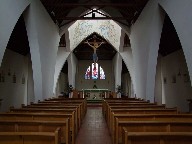 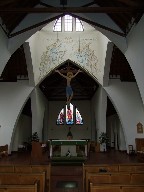 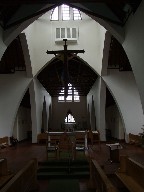 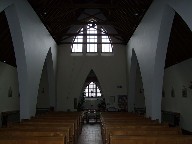
Gill made
the altar and font in his High Wycombe workshop, and it
is his lettering around the base of the altar. Some of
the decorative details within the church, like the fresco
in the tower, were completed by his son-in-law Denis
Tegetmeier to Gill's designs. The major feature which is
not the work of Gill is the east window, depicting the
Risen Christ flanked by his Blessed Mother and St Peter.
These were installed in 1963 to the design of another
High Wycombe artist, Joseph Nuttgens, who had been Gill's
friend. Nuttgens' claimed that he had helped Gill to
design the church, but had never been given credit for
this. As Gill had insisted on plain glass throughout,
Nuttgens called the east window his 'revenge on Gill',
but it is very fine, not overstated and not intrusive. It
is hard to think that the church would be improved
without it. There is more stained glass in the south
chancel chapel, by Chapel Studios, installed in 1994. It
depicts Our Lady of Walsingham and the Slipper Chapel at
the National Shrine.
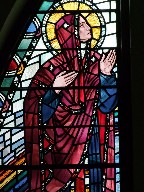  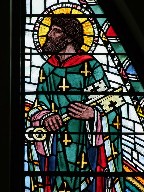
  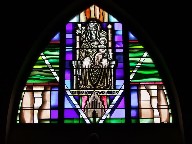
The
excellent church guide quotes FionaMacCarthy's biography
of Gill: he seized on the project as a long-awaited
opportunity to put into practice a multitude of related
ideas about building, preaching, singing, church history,
world politics, all burgeoning out from the elementary
question: What is a church? Gill chose brick for the
project rather than the contemporarily popular concrete
because he was concerned about the way local crafts were
being superceded by what he called 'mechanical town
methods'. He insisted that local workmen and artisans
were used on the project, who must have thought him a
rather wild figure with his flowing hair and monk's
robes. The church was opened on the 14th June 1939 by the
Bishop of Northampton, and it was consecrated in 1963. It
underwent a fairly major restoration in the 1990s, when
changes which had been made to the integrity in the years
since were restored to Gill's vision.
| There
is a high drama to the crossing, and the way the
arches intersect. As you walk from west to east,
towering vistas open and close. And there is a
drama to Eric Gill, of course. Fiona Macarthey's
1989 biography revealed something of Gill's
idiosyncratic, not to say scandalous, personal
life, and there were even discussions about
whether Westminster Cathedral, which has stations
of the cross by Gill, should remove them.
Fortunately, good sense prevailed. And this fine
building, put up in the very last years of the
artist's life, became a grade II* listed building
in 1994. Unfortunately, it never appears to
be open outside of Mass times, which is not just
a pity but wrong, for a Catholic church should
always be accessible to the Faithful. However, I
found the mild-mannered and pleasant parish
priest very happy to let me see inside when I
called - and, as he said to me afterwards, it is
a wonderful building indeed.
|
|
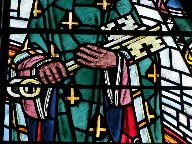 |
|
|
|
